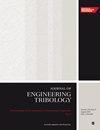干滑动条件下金属接触的摩擦和磨损研究:基于分子动力学模拟的方法
IF 1.8
3区 工程技术
Q3 ENGINEERING, MECHANICAL
Proceedings of the Institution of Mechanical Engineers, Part J: Journal of Engineering Tribology
Pub Date : 2023-12-15
DOI:10.1177/13506501231220076
引用次数: 0
摘要
由于犁耕和粘着磨损而产生的滑动摩擦严重影响了小尺寸部件(即纳米机电系统/微机电)的性能。为了全面了解摩擦机理,对纳米尺度的表面相互作用进行全面研究至关重要,尤其是在处理纳米机电和微机电元件时。本研究进行了分子动力学模拟,以探索在干燥滑动条件下纳米级表面(由相似/不相似材料制成)之间的相互作用。研究框架侧重于模拟两个半球形非球面在干滑动过程中的接触,考虑了三种材料组合:软对软(铜-铜)、硬对硬(铁-铁)和硬对软(铁-铜)。研究评估了特定滑动速度下的塑性变形和原子磨损。值得注意的是,研究结果表明,随着过盈量的增加,下表面的摩擦力也随之增加。此外,在铁-铜摩擦对中,原子磨损随着过盈量的增加而增加。由于铜的面心立方晶体结构易于滑动,因此在铜-铜摩擦对中观察到的原子磨损尤其严重。本文章由计算机程序翻译,如有差异,请以英文原文为准。
Friction and wear study of metallic contacts under dry sliding conditions: A molecular dynamics simulation-based approach
Sliding friction originating due to ploughing and adhesive wear significantly affects the performance of small-scale components, that is, nano-electromechanical systems/micro-electromechanical. To get a comprehensive understanding of the friction mechanisms, a comprehensive study of surface interactions at the nanoscale is crucial, particularly when dealing with nano-electromechanical and micro-electromechanical components. This study performed molecular dynamics simulation to explore the interactions between asperities (made of similar/dissimilar materials) at the nanoscale under dry sliding conditions. The research framework focuses on modelling the contact between two hemispherical asperities during dry sliding by considering three material combinations: soft-to-soft (Cu–Cu), hard-to-hard (Fe–Fe), and hard-to-soft (Fe–Cu). The study assesses plastic deformation and atomic wear at specific sliding speeds. Notably, the results indicate that the frictional force on the lower asperity increases as interference increases. Additionally, atomic wear rises with increased interference in the case of the Fe–Cu tribopair. Particularly high atomic wear is observed in the Cu–Cu tribopair due to the ease of slip within the face-centred cubic crystal structure of copper.
求助全文
通过发布文献求助,成功后即可免费获取论文全文。
去求助
来源期刊

CiteScore
4.20
自引率
5.00%
发文量
110
审稿时长
6.1 months
期刊介绍:
The Journal of Engineering Tribology publishes high-quality, peer-reviewed papers from academia and industry worldwide on the engineering science associated with tribology and its applications.
"I am proud to say that I have been part of the tribology research community for almost 20 years. That community has always seemed to me to be highly active, progressive, and closely knit. The conferences are well attended and are characterised by a warmth and friendliness that transcends national boundaries. I see Part J as being an important part of that community, giving us an outlet to publish and promote our scholarly activities. I very much look forward to my term of office as editor of your Journal. I hope you will continue to submit papers, help out with reviewing, and most importantly to read and talk about the work you will find there." Professor Rob Dwyer-Joyce, Sheffield University, UK
This journal is a member of the Committee on Publication Ethics (COPE).
 求助内容:
求助内容: 应助结果提醒方式:
应助结果提醒方式:


